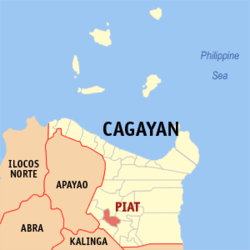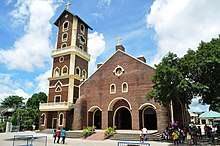Piat, Cagayan
Piat, officially the Municipality of Piat (Ibanag: Ili nat Piat; Ilocano: Ili ti Piat; Tagalog: Bayan ng Piat), is a 4th class municipality in the province of Cagayan, Philippines. According to the 2015 census, it has a population of 23,597 people.[3]
Piat | |
|---|---|
| Municipality of Piat | |
 | |
 Seal | |
| Nickname(s): Pilgrimage Center of Cagayan Valley | |
 Map of Cagayan with Piat highlighted | |
OpenStreetMap 
| |
.svg.png) Piat Location within the Philippines | |
| Coordinates: 17°47′30″N 121°28′30″E | |
| Country | |
| Region | Cagayan Valley (Region II) |
| Province | Cagayan |
| District | 2nd District |
| Founded | 1610 |
| Barangays | 18 (see Barangays) |
| Government | |
| • Type | Sangguniang Bayan |
| • Mayor | Carmelo O. Villacete |
| • Vice Mayor | Leonel C. Guzman |
| • Congressman | Samantha Louise V. Alfonso |
| • Electorate | 15,972 voters (2019) |
| Area | |
| • Total | 139.60 km2 (53.90 sq mi) |
| Population (2015 census)[3] | |
| • Total | 23,597 |
| • Density | 170/km2 (440/sq mi) |
| • Households | 5,515 |
| Economy | |
| • Income class | 4th municipal income class |
| • Poverty incidence | 14.36% (2015)[4] |
| • Revenue (₱) | 81,651,794.45 (2016) |
| Time zone | UTC+8 (PST) |
| ZIP code | 3527 |
| PSGC | |
| IDD : area code | +63 (0)78 |
| Climate type | tropical monsoon climate |
| Native languages | Ibanag Ilocano Itawis language Tagalog |
It is located in the south-west part of Cagayan province in what is known as the Itawes Region, along which the Rio Chico runs west, south, and north-west of the town until it debouches into the Rio Ibanag somewhere near Nassiping.
Piat is dubbed as the "Pilgrimage Center of Cagayan Valley" because of the thousands of devotees and tourists who come here to pay homage. It is the home of Our Lady of Piat which continues to be the source of inspiration and object of devotion of many Catholics in the region.
History
There are quite a few conjectures on how Piat got its name. One has it is that it derives from "pias," an Ilokano word, in Ibanag "addulu" and in Tagalog, "kamiyas." Another has it that the word comes from "aggapiya," meaning "healer, masseuse," and a more credible version has it that it is derived from the Ibanag and Itawes word "piya" which means "goodness, kindness, health."
The original people were the Itawes; at present, there are many Ibanag. Ilokano, Tagalog, Kapampangan and other dialect speakers. There are also families of Spanish and American descent. The head of the family was called "urayan" or "baruwang" and the council of elders "Kammaranan." There were also war leaders and braves called "mengal," and priestesses called "anitera" from the Spanish word called "anito" or "minangilu" in Ibanag, "mangilut" in Itawes and "baybaylan" in Bisayan; there were few priests among the ancient people.
In 1596, the Dominican Provincial, Fr. Miguel de San Jacinto named Piat as a mission in the Itawes region comprising the towns of Tabang, Malaueg, Tuao and Piat. The encomenderos then were Pedro Barreda, Juan de Arranda and Isabel de Cardona. In 1604, the Bishop, Diego de Soria, negotiated for more missionaries for the Itawes region. To help in the pacification and evangelization of the region, the Dominicans introduced the devotion to Our Lady of the Most Holy Rosary: in 1604, they brought the images of Our Lady from Macau and first enshrined it in Lallo, later bringing it to Piat 1622.
Barangays
Piat is politically subdivided into 18 barangays.
- Apayao
- Aquib
- Baung
- Calaoagan
- Catarauan
- Dugayung
- Gumarueng
- Macapil
- Maguilling
- Minanga
- Poblacion I
- Poblacion II
- Santa Barbara
- Santo Domingo
- Sicatna
- Villa Rey (San Gaspar)
- Villa Reyno
- Warat
Demographics
|
| |||||||||||||||||||||||||||||||||||||||||||||
| Source: Philippine Statistics Authority[3][5][6][7] | ||||||||||||||||||||||||||||||||||||||||||||||
In the 2015 census the population of Piat, Cagayan, was 23,597 people[3] with a density of 170 inhabitants per square kilometre or 440 inhabitants per square mile.
Climate
| Climate data for Piat, Cagayan | |||||||||||||
|---|---|---|---|---|---|---|---|---|---|---|---|---|---|
| Month | Jan | Feb | Mar | Apr | May | Jun | Jul | Aug | Sep | Oct | Nov | Dec | Year |
| Average high °C (°F) | 26 (79) |
27 (81) |
29 (84) |
32 (90) |
32 (90) |
32 (90) |
31 (88) |
30 (86) |
30 (86) |
29 (84) |
28 (82) |
26 (79) |
29 (85) |
| Average low °C (°F) | 21 (70) |
21 (70) |
22 (72) |
23 (73) |
24 (75) |
25 (77) |
25 (77) |
25 (77) |
24 (75) |
24 (75) |
23 (73) |
22 (72) |
23 (74) |
| Average precipitation mm (inches) | 109 (4.3) |
78 (3.1) |
64 (2.5) |
54 (2.1) |
181 (7.1) |
196 (7.7) |
204 (8.0) |
211 (8.3) |
174 (6.9) |
198 (7.8) |
185 (7.3) |
231 (9.1) |
1,885 (74.2) |
| Average rainy days | 17.2 | 13.7 | 13.2 | 13.0 | 21.7 | 23.4 | 25.2 | 25.2 | 21.9 | 17.7 | 18.6 | 20.8 | 231.6 |
| Source: Meteoblue [8] | |||||||||||||
Attractions

- Basilica of Our Lady of Piat
- This site is visited by Roman Catholic pilgrims and is believed to exhibit miracles.[9] The Basilica Minore of Our Lady of Piat is one of only 13 minor basilicas in the Philippines. It is distinguished as the home of the venerated Black Virgin Mary. The interior contains curved ceilings made of wood with historical images and accounts along the tops of the walls. Verandas inside the church add to the shrine's elegance. On the altar lies the Blessed Virgin Mary covered in glass. At the back of the church is a staircase leading to a window opening onto the back of the Virgin Mary where devotees can touch the dress of Our Lady.
- Bukal ng Buhay
- This spring allegedly bestows miracles and blessings. On April 2005 the spring started to draw crowds of devotees along with the woman who dreamed of the Miraculous Lady of Visitation of Piat. 10 years earlier while working abroad she received a dream where it was insisted that she personally go to Piat to look for the hidden spring near the sanctuary on the hill where the Miraculous Lady was being enshrined. From that day on the spring became a crowd attraction, even drawing people from the medical fields. Devotees share stories on how they get healed of their ailments or recover from their surgical operations after drinking and washing themselves with the miraculous water drawn from this “Bukal ng Buhay”. The bukal was featured on several television documentaries in the Philippines such as Rated K and Kapuso Mo, Jessica Soho.
References
- "Municipality". Quezon City, Philippines: Department of the Interior and Local Government. Retrieved 31 May 2013.
- "Province: Cagayan". PSGC Interactive. Quezon City, Philippines: Philippine Statistics Authority. Retrieved 12 November 2016.
- Census of Population (2015). "Region II (Cagayan Valley)". Total Population by Province, City, Municipality and Barangay. PSA. Retrieved 20 June 2016.
- "PSA releases the 2015 Municipal and City Level Poverty Estimates". Quezon City, Philippines. Retrieved 1 January 2020.
- Census of Population and Housing (2010). "Region II (Cagayan Valley)". Total Population by Province, City, Municipality and Barangay. NSO. Retrieved 29 June 2016.
- Censuses of Population (1903–2007). "Region II (Cagayan Valley)". Table 1. Population Enumerated in Various Censuses by Province/Highly Urbanized City: 1903 to 2007. NSO.
- "Province of Cagayan". Municipality Population Data. Local Water Utilities Administration Research Division. Retrieved 17 December 2016.
- "Piat, Cagayan: Average Temperatures and Rainfall". Meteoblue. Retrieved 15 December 2018.
- Piat Basilica
External links
| Wikimedia Commons has media related to Piat, Cagayan. |